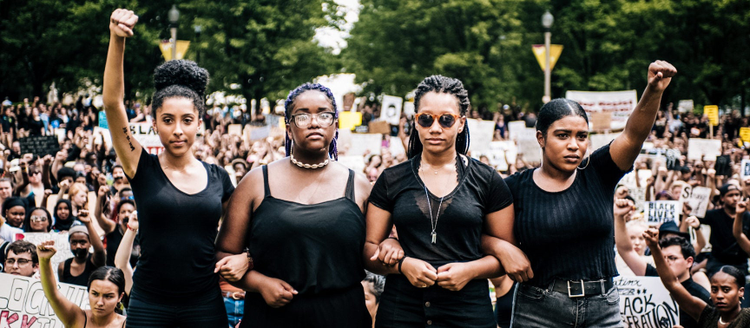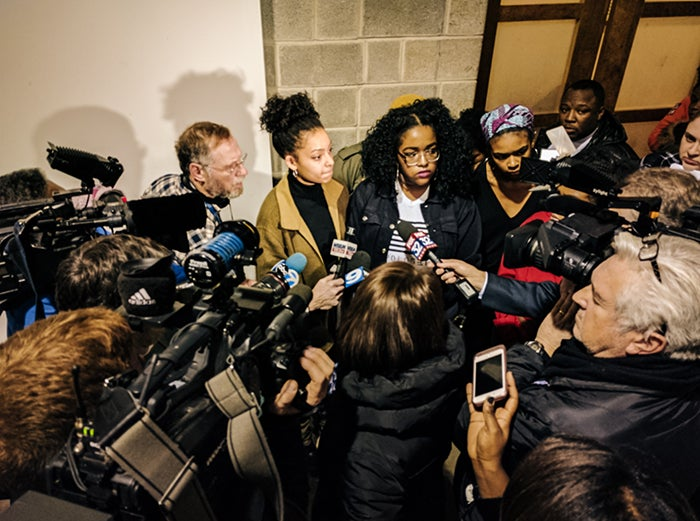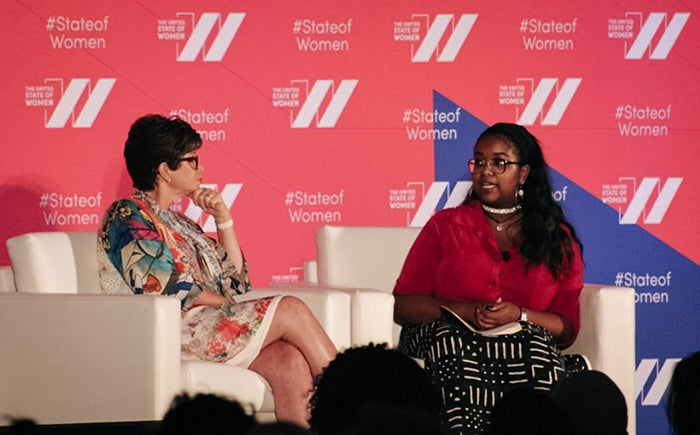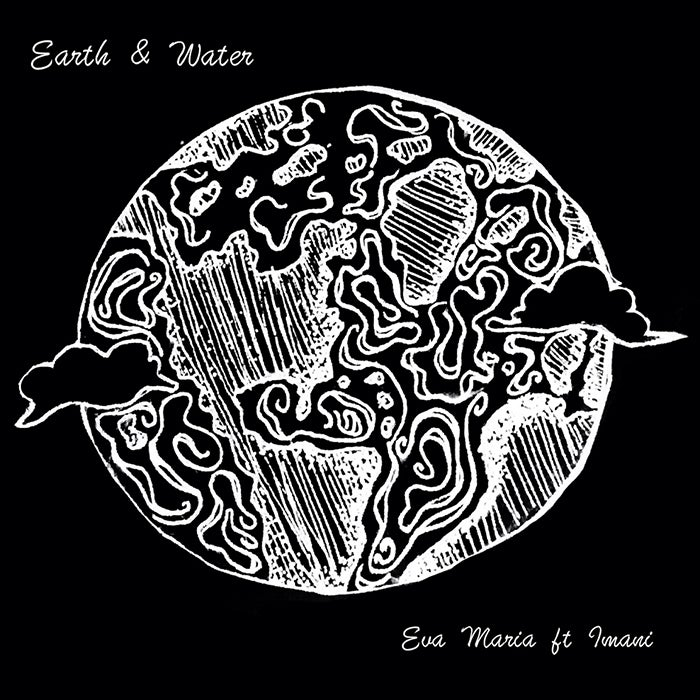What’s the Difference Between an Advocate and an Activist? Have You Been Mislabeling?

Eva Lewis (second from left) with her fellow Youth for Black Lives founders at the 2016 Chicago Youth Sit In. Photo: Colin Boyle
Eva Lewis is an eighteen-year-old advocate and activist. She most recently spoke at TEDxTeen about her role in creating The I Project, which combines art and activism to advocate for intersectionality. Eva shares her perspective on the power of advocacy with an examination of activism, art, and the intersections between them.
With the rise of social media, we have somehow collectively forgotten the differences between the words ‘activist’ and ‘advocate’. I learned the functions of these words during my time at the United Nations Commission on the Status of Women in 2015.

Eva performing a slam poem at the International Day of the Girl at the United Nations in 2016
To be an activist is to act on behalf of solving social and political issues. It is to be at the forefront of a movement, often times compromising your own energy in order to seek justice and evoke change.
“To be an activist is to speak. To be an advocate is to listen. Society can’t move forward without both.”
To be an advocate is to speak and learn about social and political issues. It is to bring attention to an injustice, subsequently aiding the activist in their fight against that same injustice. Although different, both are necessary in order to create systemic change. Without one, the other cannot function.

Eva and the members of Youth for Black Lives answer questions from press after meeting with Superintendent of Chicago Police Eddie Johnson
Social media has been helpful in exposing injustice, and in bringing pivotal conversations from a grassroots level to the forefront of popular conversation. As a result, narratives are being changed at a large scale and movements are gaining momentum much more rapidly than they have in the past.
“We need more advocates who amplify the problems occuring in society.”
Police brutality has been occurring since the inception of police, but with social media a much greater amount of the public has acknowledged it as a social and political issue. The ways in which we use social media as an advocacy mechanism are productive. Within that, we have created a problematic paradox that values the title of activist, and not the work needed to create the change we want to see.
We have taken the meaning and power from the word ‘advocate,’ nearly eradicating a necessary role in the fight for change.
“Social media has the potential to garner millions of advocates. It is time that we hold each other accountable to use these resources.”
By unanimously claiming ‘activist,’ there is no room for a dichotomy between the activists who execute and the advocates who amplify. We are paying too much attention to the ‘clout’ behind activism, and not the advocacy at its foundation. We need more advocates who amplify the problems occurring in society.

Eva speaking with Former Senior Advisor Valerie Jarrett at the United State of Women Galvanize Project Summit in 2017
Social media has the potential to garner millions of advocates for an array of social and political issues that desperately need our time and energy. With access to a plethora of information, there are ways to advocate for these issues in a meaningful and accessible way. It is time that we hold each other accountable to use these resources.
“It is important to recognize that our voices might not always be the one that needs to be elevated. A dialogue cannot occur when everyone in the room is speaking.”
Accountability as an advocate is as simple as using a hashtag, defending a peer online, or creating an online dialogue in support of an issue. Each of us has an individual platform which begins with an @. That platform can be powerful if used to draw attention to activists and artists who are initializing change. Collectively, we can create an online symbiosis geared at elevating the narratives and initiatives society has suppressed for centuries before us.

Photo by Brett Bulthuis. Eva Lewis and Lena Waithe in a conversation moderated by Elaine Welteroth at the Teen Vogue Summit meetup in Chicago
At the same time, it is important to recognize that our voices might not always be the one that needs to be elevated. A dialogue cannot occur when everyone in the room is speaking.
There are two parts to advocacy: vocalizing and amplifying. Although every voice is important, everyone should not be speaking. We must acknowledge our privilege and take a step back to amplify the voices of others, especially when they are advocating for their own intersections.
“I retweeted anything that I shared belief in. It was a while before I was able to recognize this process as advocacy.”
This process isn’t new. Throughout time, we have practiced advocacy by amplifying the works of activists who move through art. Art is inherently radical because it tells a narrative counter to that which has been deemed true by society. It is an accessible medium, being understood uniquely by each person who engages with it. Art has the power to bring people together, and because of our personal understanding of it, we share it over and over and over again. That in itself is advocacy, because we are amplifying the voice of the artist, or activist, who is sharing the work in order to combat a social or political issue.

Cover art for Eva’s single, Earth & Water, illustrated by Ondine Atwell-Hudson
I first became involved with activism through art by using my social media as a platform for advocacy and amplification. I started a twitter account my sophomore year of high school. Although I was already delving into poetry, I didn’t quite understand the political and social implications behind that work as well as other mediums. For a moment, I wouldn’t even tweet. I instead retweeted slam poetry, paintings, 140 character manifestos, anything I saw that I shared belief in. It was a while before I was able to recognize this process as advocacy.
My advocacy led me into my activism. I became curious as to how I could use my voice to evoke change through my own art. I attended more events, read more articles, and engaged in more dialogue until eventually I was ready to make my own statement. My junior year of high school, less than a year after being exposed to advocacy via social media, I founded my own project, The I Project.
The I Project is an initiative to humanize youth affected by intersectionality through an activism through arts approach. I began with writing articles and interviewing people in order to create a list of narratives people told for themselves. Activism through art opened avenues for other types of change. Soon, it developed into doing large group projects, hosting events, and eventually combatting direct systemic oppression through outreach and fundraising initiatives.
“There is power at our fingertips. We only need to discover this power to create the change we need to see.”
The Education Emancipation campaign aims to provide resources to elementary schools on the south and west sides of Chicago. We are currently partnering with Bouchet Elementary, a predominantly black school in Chicago’s South Shore neighborhood, where I grew up. If we raise $25,000, each child at Bouchet will receive an in-school Chromebook. After the fundraising, we plan on fully investing in the school so that we can ensure the students academic and life success by any means necessary.
My journey to help my people started with advocacy, advocating for causes and amplifying the voices of those doing the work at the forefronts of movements. The power of advocacy, and the power of art, aided me in creating my own real-life platform that focuses on creating real systemic change.
In the age of social media, the first stepping stone into activism, advocacy, is more accessible than ever. My journey is not a unique one. Every day, people are discovering their voices through advocacy, and making the transition from their online platform to the physical world. There is actual power at our fingertips. We only need to discover this power to create the change we need to see.
Want to learn more about Eva? Watch her TEDxTeen talk.